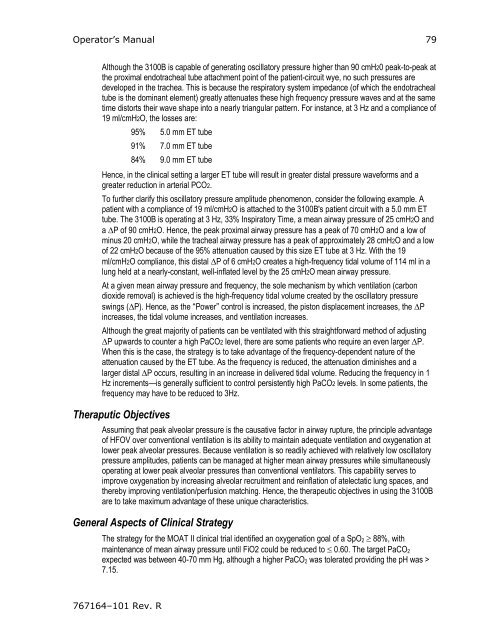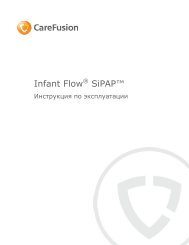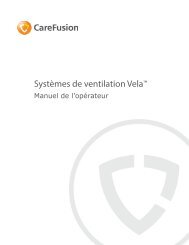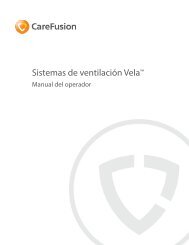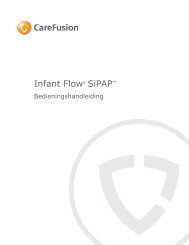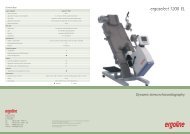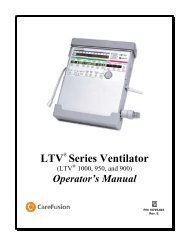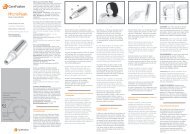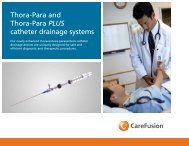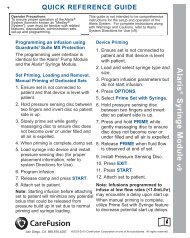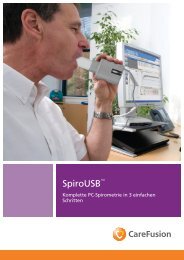3100B HFOV Operator Manual - CareFusion
3100B HFOV Operator Manual - CareFusion
3100B HFOV Operator Manual - CareFusion
Create successful ePaper yourself
Turn your PDF publications into a flip-book with our unique Google optimized e-Paper software.
<strong>Operator</strong>’s <strong>Manual</strong> 79<br />
Although the <strong>3100B</strong> is capable of generating oscillatory pressure higher than 90 cmH20 peak-to-peak at<br />
the proximal endotracheal tube attachment point of the patient-circuit wye, no such pressures are<br />
developed in the trachea. This is because the respiratory system impedance (of which the endotracheal<br />
tube is the dominant element) greatly attenuates these high frequency pressure waves and at the same<br />
time distorts their wave shape into a nearly triangular pattern. For instance, at 3 Hz and a compliance of<br />
19 ml/cmH2O, the losses are:<br />
95% 5.0 mm ET tube<br />
91% 7.0 mm ET tube<br />
84% 9.0 mm ET tube<br />
Hence, in the clinical setting a larger ET tube will result in greater distal pressure waveforms and a<br />
greater reduction in arterial PCO2.<br />
To further clarify this oscillatory pressure amplitude phenomenon, consider the following example. A<br />
patient with a compliance of 19 ml/cmH2O is attached to the <strong>3100B</strong>'s patient circuit with a 5.0 mm ET<br />
tube. The <strong>3100B</strong> is operating at 3 Hz, 33% Inspiratory Time, a mean airway pressure of 25 cmH2O and<br />
a ∆P of 90 cmH2O. Hence, the peak proximal airway pressure has a peak of 70 cmH2O and a low of<br />
minus 20 cmH2O, while the tracheal airway pressure has a peak of approximately 28 cmH2O and a low<br />
of 22 cmH2O because of the 95% attenuation caused by this size ET tube at 3 Hz. With the 19<br />
ml/cmH2O compliance, this distal ∆P of 6 cmH2O creates a high-frequency tidal volume of 114 ml in a<br />
lung held at a nearly-constant, well-inflated level by the 25 cmH2O mean airway pressure.<br />
At a given mean airway pressure and frequency, the sole mechanism by which ventilation (carbon<br />
dioxide removal) is achieved is the high-frequency tidal volume created by the oscillatory pressure<br />
swings (∆P). Hence, as the “Power” control is increased, the piston displacement increases, the ∆P<br />
increases, the tidal volume increases, and ventilation increases.<br />
Although the great majority of patients can be ventilated with this straightforward method of adjusting<br />
∆P upwards to counter a high PaCO2 level, there are some patients who require an even larger ∆P.<br />
When this is the case, the strategy is to take advantage of the frequency-dependent nature of the<br />
attenuation caused by the ET tube. As the frequency is reduced, the attenuation diminishes and a<br />
larger distal ∆P occurs, resulting in an increase in delivered tidal volume. Reducing the frequency in 1<br />
Hz increments—is generally sufficient to control persistently high PaCO2 levels. In some patients, the<br />
frequency may have to be reduced to 3Hz.<br />
Theraputic Objectives<br />
Assuming that peak alveolar pressure is the causative factor in airway rupture, the principle advantage<br />
of <strong>HFOV</strong> over conventional ventilation is its ability to maintain adequate ventilation and oxygenation at<br />
lower peak alveolar pressures. Because ventilation is so readily achieved with relatively low oscillatory<br />
pressure amplitudes, patients can be managed at higher mean airway pressures while simultaneously<br />
operating at lower peak alveolar pressures than conventional ventilators. This capability serves to<br />
improve oxygenation by increasing alveolar recruitment and reinflation of atelectatic lung spaces, and<br />
thereby improving ventilation/perfusion matching. Hence, the therapeutic objectives in using the <strong>3100B</strong><br />
are to take maximum advantage of these unique characteristics.<br />
General Aspects of Clinical Strategy<br />
The strategy for the MOAT II clinical trial identified an oxygenation goal of a SpO 2 ≥ 88%, with<br />
maintenance of mean airway pressure until FiO2 could be reduced to ≤ 0.60. The target PaCO 2<br />
expected was between 40-70 mm Hg, although a higher PaCO 2 was tolerated providing the pH was ><br />
7.15.<br />
767164–101 Rev. R


